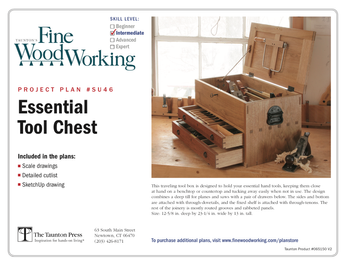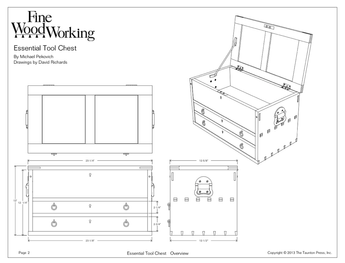Just wondering if anyone sharpens lathe tools on a sander vs grinding? I am learning and cursing at the grinder, while eye-ing my friendly belt/disk sander. Seems to me it would be easier to see and control at the sander, but infer there must be reasons its not done.
Discussion Forum
Get It All!
UNLIMITED Membership is like taking a master class in woodworking for less than $10 a month.
Start Your Free TrialCategories
Discussion Forum
Digital Plans Library
Member exclusive! – Plans for everyone – from beginners to experts – right at your fingertips.
Highlights
-
Shape Your Skills
when you sign up for our emails
This site is protected by reCAPTCHA and the Google Privacy Policy and Terms of Service apply. -
 Shop Talk Live Podcast
Shop Talk Live Podcast -
 Our favorite articles and videos
Our favorite articles and videos -
E-Learning Courses from Fine Woodworking
-
-












Replies
I sharpen my HSS lathe tools freehand on a disk sander (off the belt sander combo). Razor sharp in seconds.
Regards from Perth
Derek
I use the lathe only occasionally for furniture parts, but I've always used the belt sander for sharpening tools. It doesn't overheat the metal, and it's quite easy to set up a metal jig attached to the stop to hold tools securely at the correct angle.
I recently got rid of my sander and replaced it with a Ridgid, and so far I've been too lazy to figure out a jig for that, but I'll come up with something.
Jim
I use a grinder but just about any sander will work fine. Sanders usually run at 1750 rpm or less if it is variable speed. Try a belt or disc sander, if you get good results then save the grinder for other work.
mike
Both disc sander and belt sander or preferably belt grinder are highly convenient for free hand or jigged grinding , shaping or sharpening of lathe tools. You need to have suitable discs and belts ofcourse.
I have several disc sanders, one of which is attached to the outboard side of my lathe for quick access. I also use my belt grinder -here different diameter contact wheels and different types (hard, soft, serrated etc) give various finishes as required.
I think these machines are extremely versatile in any wood and or metal shop. Certainly the belt grinder is relatively unknown to woodworkers and they lose out on this -even those *small high speed versions that run a narrow belt (one inch or so) are great for sorting out lathe chisels in short time. Far superior to the bench grinder which is really a narrow scope machine more suited to certain aspects of metal working.
*If you are doing a lot of turning then you could consider that machine or the Elu combination that I have pictured from the manual.
Philip Marcou
Edited 8/30/2008 5:21 am by philip
Stan,
The Elu belt sander/grinder got left out. It is a combination sander , grinder with jig attachment for grinding chisels, plane blades etc, plus a leather belt for stropping.Philip Marcou
Great post Phillip. I enjoyed learning about your sharpening methods. I'm going to utilize the outboard side of my lathe to do some sharpening also
What grit do you advise? Excellent photos
Thanks,
Rick
Thanks to all who responded. I am new to turning and all the references I have looked at and the turners I talked to, all talk about grinders. I was hoping there was no inherent technical reason for not using sanders. I'd prefer to save the grinder for the garden tools and mower blades.
.....and all the references I have looked at and the turners I talked to, all talk about grinders. "
If they are only talking about using bench grinders one can only assume that they are Followers of the Unenlightened Masses (fums). They need to talk about and then use such little machines as that Elu-which has been designed and made especially for them (;).
I hope you get your shop up and running soon.Philip Marcou
An expansion on what GRW said - If you're pressing your shop disc/belt sander into service for this purpose, and its a modern machine with plastic end guards, remove them. I use my delta belt sander for lots of metal working operations, like thinning out plane blades to fit a plane body, establishing bevels on new chisels, etc..., and the metal coming off those tools can (and has) melted and smoldered the plastic guards.
I use my portable belt sander clamped upside-down in a shoulder vise. Before I do use it, though, I clean it thoroughly with compressed air and dump the bag. This is vital safety-wise.I had a similar thing with smoke in the shop and found out that it was sawdust in the back of my belt sander smoldering.
I saw a belt sander catch on fire about an hour after it had been used - the belt had apparently run across the top of a brad that wasn't countersunk deeply enough and it put hot metal in the bag with the dust. SOP in that particular shop after that incident is that all belt sanders had to be emptied in a steel drum outside immediately after each use.
This would have been disastrous if the sander had been used close to quittin' time.
what grit sand paper do you use?
yep I change my oil every 3000 miles or when I get bored...which ever comes first
Stan,
I used my stationary belt/disk sander before and it worked great. I didn't turn on the dust collector because I thought it might be a fire hazard. I don't do it any more though and this is why.
One day after I sharpened a tool and I left the shop for a while. When I returned I could smell smoke in the shop. I couldn't see any smoke. I looked everywhere I could think of and couldn't find the source. I thought I might have had a friction burn while working on a piece of maple earlier. Though I couldn't remember that happening. Well the smokey smell didn't go away, and seemed like it was getting worse. When I looked again I found that a thin film of dust under my sander was smoldering and spreading at a fast rate. I put the fire out. I don't know if this small fire would have spread. But I know my shop conditions are such that it could have, and fast.
Your experience with the fire is similar to an experience that one of the members of our woodturning club had. He has the large Powermatic belt sander and it probably had a good accumulation of wood dust built up from years of use and not much internal cleaning (as in NONE). Since it was closer to the lathe than the bench grinder, he frequently used the belt sander to touch up a bowl gouge edge. One day, he kept smelling smoke and by the time that he figured out that there was a fire in the sander, it was, in the jargon of the firemen, "fully involved". Once the sander was dried out from its dousing with water, it did not seem to be much worse for the wear other than a new patina to the standard Powermatic yellow.
It's another expense, but the Worksharp is a GREAT tool for this. I am just learning too, but invested in this sanding sharpener. It has an angled guide specifically for things like chisels, etc., you can set the angle. It also has a "see-through" disc used for sharpening lathe toos from the bottom, but you can see the sharpening as it takes place because of the slotted disc. Just use a permanent marker to "paint" the bevel, then when the marker has been sanded off, the tool is sharp.
This eliminates the danger of using a belt sander that may ignite dust.
This forum post is now archived. Commenting has been disabled